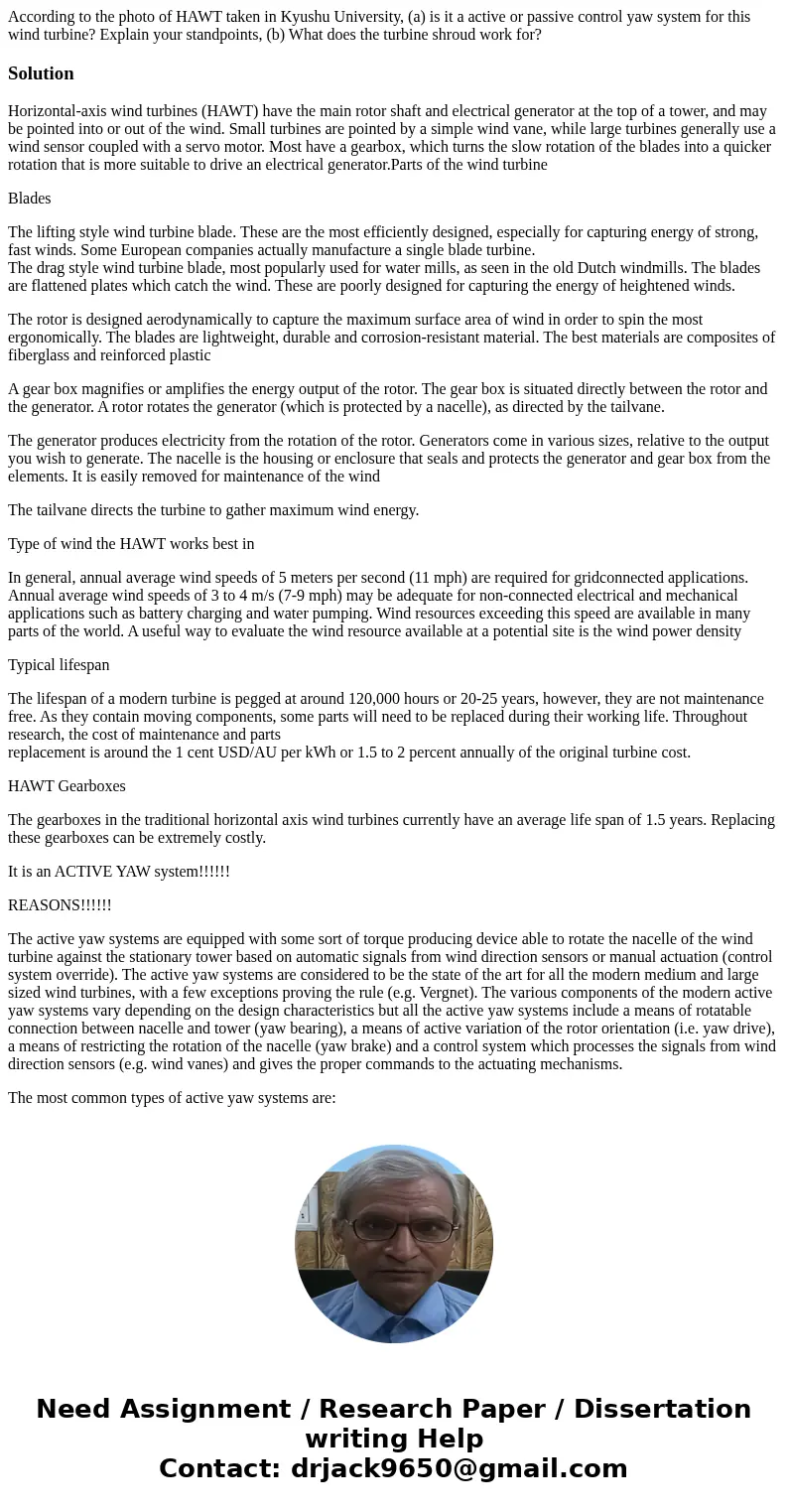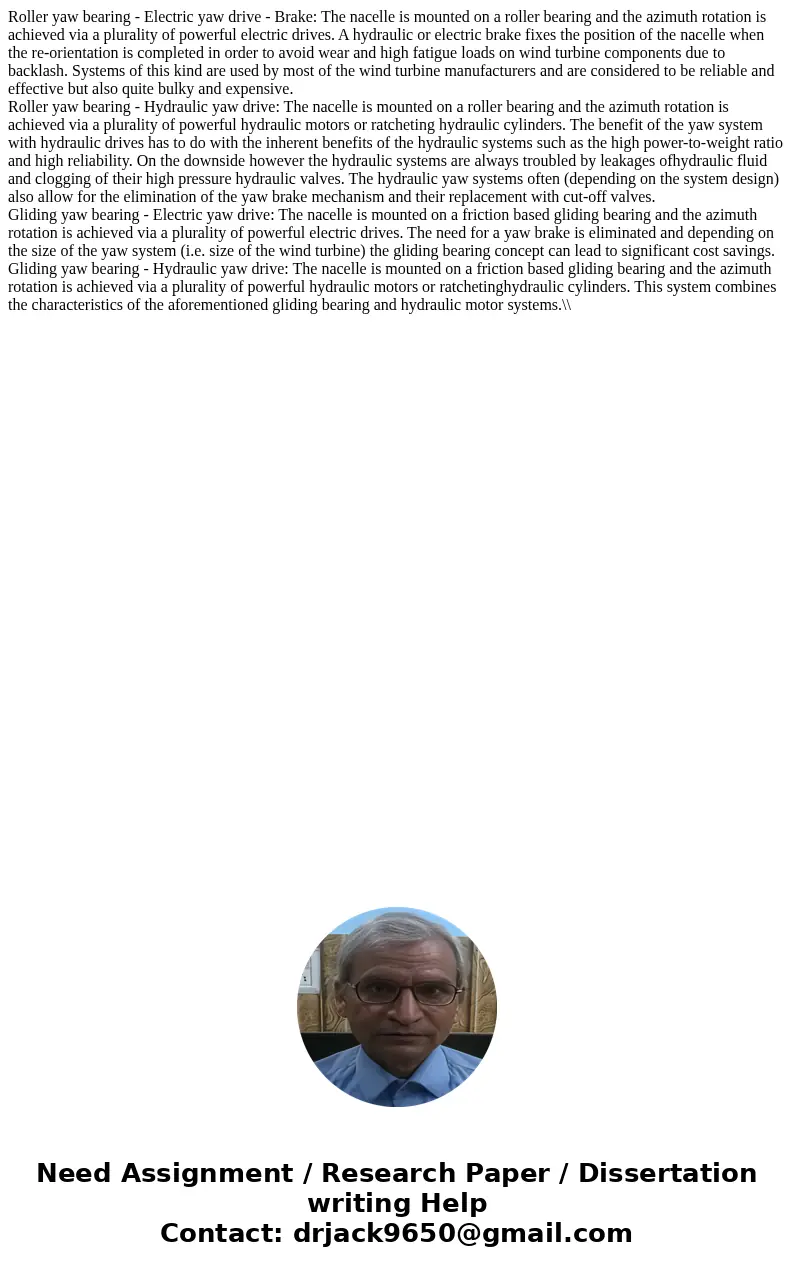According to the photo of HAWT taken in Kyushu University a
Solution
Horizontal-axis wind turbines (HAWT) have the main rotor shaft and electrical generator at the top of a tower, and may be pointed into or out of the wind. Small turbines are pointed by a simple wind vane, while large turbines generally use a wind sensor coupled with a servo motor. Most have a gearbox, which turns the slow rotation of the blades into a quicker rotation that is more suitable to drive an electrical generator.Parts of the wind turbine
Blades
The lifting style wind turbine blade. These are the most efficiently designed, especially for capturing energy of strong, fast winds. Some European companies actually manufacture a single blade turbine.
The drag style wind turbine blade, most popularly used for water mills, as seen in the old Dutch windmills. The blades are flattened plates which catch the wind. These are poorly designed for capturing the energy of heightened winds.
The rotor is designed aerodynamically to capture the maximum surface area of wind in order to spin the most ergonomically. The blades are lightweight, durable and corrosion-resistant material. The best materials are composites of fiberglass and reinforced plastic
A gear box magnifies or amplifies the energy output of the rotor. The gear box is situated directly between the rotor and the generator. A rotor rotates the generator (which is protected by a nacelle), as directed by the tailvane.
The generator produces electricity from the rotation of the rotor. Generators come in various sizes, relative to the output you wish to generate. The nacelle is the housing or enclosure that seals and protects the generator and gear box from the elements. It is easily removed for maintenance of the wind
The tailvane directs the turbine to gather maximum wind energy.
Type of wind the HAWT works best in
In general, annual average wind speeds of 5 meters per second (11 mph) are required for gridconnected applications. Annual average wind speeds of 3 to 4 m/s (7-9 mph) may be adequate for non-connected electrical and mechanical applications such as battery charging and water pumping. Wind resources exceeding this speed are available in many parts of the world. A useful way to evaluate the wind resource available at a potential site is the wind power density
Typical lifespan
The lifespan of a modern turbine is pegged at around 120,000 hours or 20-25 years, however, they are not maintenance free. As they contain moving components, some parts will need to be replaced during their working life. Throughout research, the cost of maintenance and parts
replacement is around the 1 cent USD/AU per kWh or 1.5 to 2 percent annually of the original turbine cost.
HAWT Gearboxes
The gearboxes in the traditional horizontal axis wind turbines currently have an average life span of 1.5 years. Replacing these gearboxes can be extremely costly.
It is an ACTIVE YAW system!!!!!!
REASONS!!!!!!
The active yaw systems are equipped with some sort of torque producing device able to rotate the nacelle of the wind turbine against the stationary tower based on automatic signals from wind direction sensors or manual actuation (control system override). The active yaw systems are considered to be the state of the art for all the modern medium and large sized wind turbines, with a few exceptions proving the rule (e.g. Vergnet). The various components of the modern active yaw systems vary depending on the design characteristics but all the active yaw systems include a means of rotatable connection between nacelle and tower (yaw bearing), a means of active variation of the rotor orientation (i.e. yaw drive), a means of restricting the rotation of the nacelle (yaw brake) and a control system which processes the signals from wind direction sensors (e.g. wind vanes) and gives the proper commands to the actuating mechanisms.
The most common types of active yaw systems are:
Roller yaw bearing - Electric yaw drive - Brake: The nacelle is mounted on a roller bearing and the azimuth rotation is achieved via a plurality of powerful electric drives. A hydraulic or electric brake fixes the position of the nacelle when the re-orientation is completed in order to avoid wear and high fatigue loads on wind turbine components due to backlash. Systems of this kind are used by most of the wind turbine manufacturers and are considered to be reliable and effective but also quite bulky and expensive.
Roller yaw bearing - Hydraulic yaw drive: The nacelle is mounted on a roller bearing and the azimuth rotation is achieved via a plurality of powerful hydraulic motors or ratcheting hydraulic cylinders. The benefit of the yaw system with hydraulic drives has to do with the inherent benefits of the hydraulic systems such as the high power-to-weight ratio and high reliability. On the downside however the hydraulic systems are always troubled by leakages ofhydraulic fluid and clogging of their high pressure hydraulic valves. The hydraulic yaw systems often (depending on the system design) also allow for the elimination of the yaw brake mechanism and their replacement with cut-off valves.
Gliding yaw bearing - Electric yaw drive: The nacelle is mounted on a friction based gliding bearing and the azimuth rotation is achieved via a plurality of powerful electric drives. The need for a yaw brake is eliminated and depending on the size of the yaw system (i.e. size of the wind turbine) the gliding bearing concept can lead to significant cost savings.
Gliding yaw bearing - Hydraulic yaw drive: The nacelle is mounted on a friction based gliding bearing and the azimuth rotation is achieved via a plurality of powerful hydraulic motors or ratchetinghydraulic cylinders. This system combines the characteristics of the aforementioned gliding bearing and hydraulic motor systems.\\


 Homework Sourse
Homework Sourse